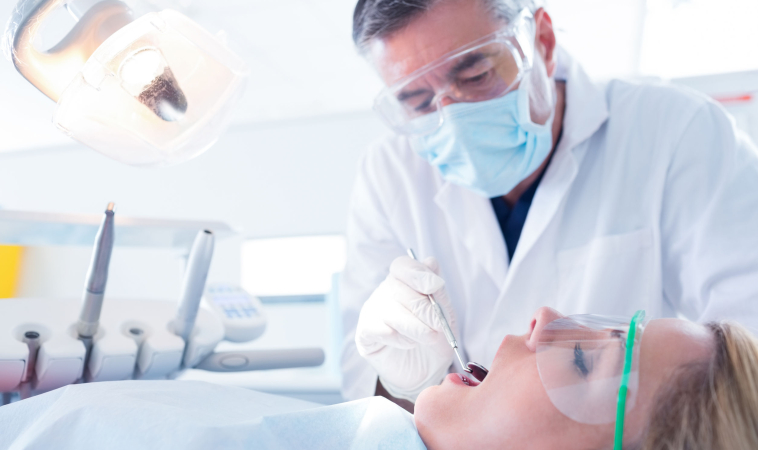The dentist’s office is one place that most people don’t look forward to visiting. Our mouths are very personal places, and the vicinity to our noses make us emotionally reactive to the smells, correlating the experience with the scent of medical gloves and fluoride. That uncomfortable feeling of tools and hands in your mouth. Your lips are stretched and dry. The hygienist or dentist talks to you, and awkwardly you try to reply with primitive sounds, feeling frustrated. And then of course the ultimate question comes along: How often do you floss? Your hygienist isn’t trying to make you feel bad. This is a more critical concern than we may believe. We know that dental cleanings are good for our oral health but how often do we think about how our oral health affects the health of our entire body? And how often do we actually comply with periodontal health practices? We should be brushing and flossing daily to maintain the health of our gums and teeth, however, this is especially important in pregnant women and those looking to conceive.
Consider this: The mouth isn’t just the cavity (no pun intended) that leads to our stomach and gastrointestinal tract, but it can be a gateway for some substances to the blood stream. Ever wonder why you need antibiotics while having dental work done? Or why it’s so important to be on antibiotics for strep throat (pharyngeal streptococcal) infection? It’s not for your oral health, but for your heart! A simple oral or throat infection can easily move into your bloodstream and affect the heart, causing rheumatic disease, inflammation of the heart, and chest pain1. With recurrent infections, this can lead to damaged heart valves.
Periodontal disease and Inflammation
This is just one example of where oral health seems to affect systemic health. Studies have linked chronic oral infections to diabetes, lung diseases, risk of stroke, and low-birthweight, premature births2. Periodontal diseases include gingivitis, associated with gum inflammation and/or bleeding gums, as well as periodontitis, an inflammatory disease of the structures and tissues around the teeth3.
Periodontal diseases are most commonly caused by the presence and proliferation of specific microorganisms4. The presence of plaques, containing these groups of microorganisms, elicits an immune response and the production of inflammatory cytokines, as well as reactive oxygen species (ROS). The resultant inflammation leads to destruction of the supporting structures around the teeth4. Manifestations of this tissue loss includes a receding gum line and the actual loss of teeth; Its primary cause: poor oral hygiene, neglecting to remove plaque from teeth and the gum line4.
Oral Health and Pregnancy
Oral microorganisms are often responsible for many of the inflammatory processes in the oral cavity. Certain bacterial species can initiate inflammatory cascades in the surrounding periodontal tissue, leading to an increased risk for gingivitis and periodontitis5.
In general, periodontal disease is associated with an increased risk of preterm birth (less than 37 weeks) and low birth weight6. Other studies have linked periodontal diseases in pregnancy with preeclampsia and gestational diabetes mellitus3. Seeing as how about 60-75% of pregnant woman have gingivitis3, education and oral hygiene practices are crucial for prenatal health – both for mom and baby.
The body is constantly working to “neutralize” ROS with antioxidants. Inflamed periodontal tissue, including gingivitis has been shown to exhibit markers for increased amounts of oxidative stress5. Not only was this shown in gingival tissue, but also systemically in plasma and red blood cells5. One study showed that markers of oxidative stress in saliva samples are more elevated in pregnancy than in non-pregnant controls. This leads to the idea that pregnancy puts a higher burden of oxidative stress on the body in general, but concurrent periodontal disease and inflammation would create an even higher demand for antioxidant support. If left unaddressed, tissue damage, whether local or systemic, may occur but it is unsure as to the degree of damage.
One way to assist the body in its continual balance of ROS and antioxidant activity is to include antioxidants in the diet in the form of vitamin C and vitamin E4. Berries, in particular, are a great source of antioxidants and should be encouraged in the diet4.
Additionally, decreasing sugar, especially refined sugar, in the diet can help prevent the proliferation of microorganism colonies, and reduce plaque build-up4.
Improving Periodontal Health
One of the best ways to prevent inflammatory factors and ROS from destroying periodontal tissues is to prevent the formation of plaque, and remove plaque from the surface of and the crevices between teeth. Dental flossing remains a crucial part of dental hygiene and overall health, and although many of us neglect this daily practice, perhaps these fairly recent insights into pregnancy care, cardiovascular health and chronic health outcomes will inspire us to make oral hygiene a priority.
Apart from dental flossing, positive outcomes in gingival health have been seen from a practice known as “oil pulling”. Oil pulling is a traditional Indian folk remedy consisting of swishing coconut, sesame or sunflower oil around the oral cavity as a means to strengthen teeth and gums7,8. Additionally its benefits extend to improving halitosis (bad breath), treating and preventing bleeding gums, and mouth dryness7.
So how exactly does it work? Some say that the oils themselves have properties that help eliminate bacteria and are good for overall health. Lignans in sesame oil have a degree of antioxidant properties, but one of best theories of how oil pulling works is via saponification and emulsification: it mechanically cleans teeth by surrounding and trapping bacteria and toxins, holding them captive so you can easily spit out these mini oil “packages” of microorganisms9.
Studies have shown that oil pulling therapy significantly decreases plaque scores and plaque-induced gingivitis7,8. This practice has also been shown to be as effective as chlorhexidine oral rinses in the prevention of plaque-induced gingivitis7, but without the risk of staining the teeth and oral surfaces, common with chronic and continual use of chlorhexidine rinses8,10. Chlorhexidine also carries a potential side effect of changing the user’s perception of taste10. Oil pulling therefore is an appropriate and effective alternative for individuals who have experienced side effects of chlorhexidine rinses, or who have a sensitivity to ethanol alcohol and or artificial food dyes11.
How to do Oil Pulling
For anyone who is interested in improving their oral health, I recommend a trial of oil pulling as its effects are noticeable and can be quite dramatic depending on your current oral health status. Oil pulling is best done first thing in the morning before eating and brushing the teeth. Start by scooping a tablespoon of oil into the mouth and holding it there. Swish it all around the mouth for about 10-15 minutes, but do not swallow it! Since the oil is used to clean the mouth it does a great job of holding onto toxins and bacteria, so we really don’t want that to go back into our body. The oil will thin and turn a milky colour, so don’t worry if it keeps mixing with saliva – this is normal7. Once your time is up, spit out the oil and the contents of the mouth, and follow with normal teeth brushing.
Conclusions
Our oral and periodontal health is essentially linked to our overall health. Though we might associate a visit to the dentist with the fear of finding cavities, getting fillings, or other painful procedures, the importance of oral hygiene cannot be understated. Don’t hesitate to ask a dental hygienist to go over proper flossing techniques with you. Give oil pulling a try and see what your hygienist and dentist report to you about the health of your gums.
 Dr. Sarah King is a licensed Naturopathic Doctor, graduating from the Canadian College of Naturopathic Medicine in 2014. Prior to completing her medical studies, she attended Nipissing University where she received her Honors Bachelor of Science in Biology. Sarah has a passion for women’s health and is a birth doula in Durham and Toronto Region. She treats a wide variety of health conditions including menstrual disorders and hormone balancing, fertility, prenatal care, digestive concerns, skincare and mental health/anxiety. Outside the office Sarah is an avid runner with a love of the GTA’s best forest trails. She also continues to improve her yoga practice and teaches breath work as part of stress management counselling to her patients.
Dr. Sarah King is a licensed Naturopathic Doctor, graduating from the Canadian College of Naturopathic Medicine in 2014. Prior to completing her medical studies, she attended Nipissing University where she received her Honors Bachelor of Science in Biology. Sarah has a passion for women’s health and is a birth doula in Durham and Toronto Region. She treats a wide variety of health conditions including menstrual disorders and hormone balancing, fertility, prenatal care, digestive concerns, skincare and mental health/anxiety. Outside the office Sarah is an avid runner with a love of the GTA’s best forest trails. She also continues to improve her yoga practice and teaches breath work as part of stress management counselling to her patients.
References
1 Gladwin, Mark, and Bill Trattler. Clinical Microbiology Made Ridiculously Simple. Miami: MedMaster, 2007 pp. 22-25. Print.
2 Paquette, D.W., Bell, K.P., Phillips, C., et al. “Dentists’ knowledge and opinions of oral-systemic disease relationships: relevance to patient care and education” (2015) J Dent Educ. 79(6):626-35
3 Hartnett, E., Haber, J., Krainovich-Miller, B., et al. “Oral health in pregnancy” (2016) J Obstet Gynecol Neonatal Nurs.45(4) 565-73
4 Najeeb, S., Zafar, M.S., Khurshid, Z., et al. “The role of nutrition in periodontal health: An update” (2016) Nutrients. 8(9): Pii:E530
5 Gümüş, P., Emingil, G., Öztürk, V-O., et al. “Oxidative stress markers in saliva and periodontal disease status: modulation during pregnancy and postpartum” (2015) BMC Infect Dis.15: 261
6 Reza Karimi, M., Hamissi, J.H., Nagini, S.R., and Karimi, M. The relationship between maternal periodontal status of and preterm and low birth weight infants in Iran: A case control study” (2015) Glob J Health Sci. 8(5): 184-8
7 Asokan, S., Emmadi, P., and Chamundeswari, R. “Effect of oil pulling on plaque induced gingivitis: a randomized, controlled, triple-blind study” (2009) Indian J Dent Res. 20(1): 47-51
8 Peedikavil, F.C., Sreenivasan, P and Narayanan, A. “Effect of coconut oil in plaque related gingivitis – a preliminary report” (2015) Niger Med J. 56(2): 143-147
9 Asokan, S., Rathinasamy, T.K., Inbamani, N., et al. “Mechanism of oil-pulling therapy – in vitro study” (2011) Indian J Dent Res. 22(1): 34-7
10 FDA. SpringerReference. PeridexTM (CHLORHEXIDINE GLUCONATE 0.12%) ORAL RINSE. FDA, Jan. 2003. Web. 12 Sept. 2016. <http://www.accessdata.fda.gov/drugsatfda_docs/label/2013/019028s020lbl.pdf>.
11 Kaushik, M., Reddy, P., Sharma, R., et al. “The effect of coconut oil pulling on streptococcus mutant count in saliva in comparison with chlorhexidine mouthwash” (2016) J Contemp Dent Pract. 17(1): 38-41
















